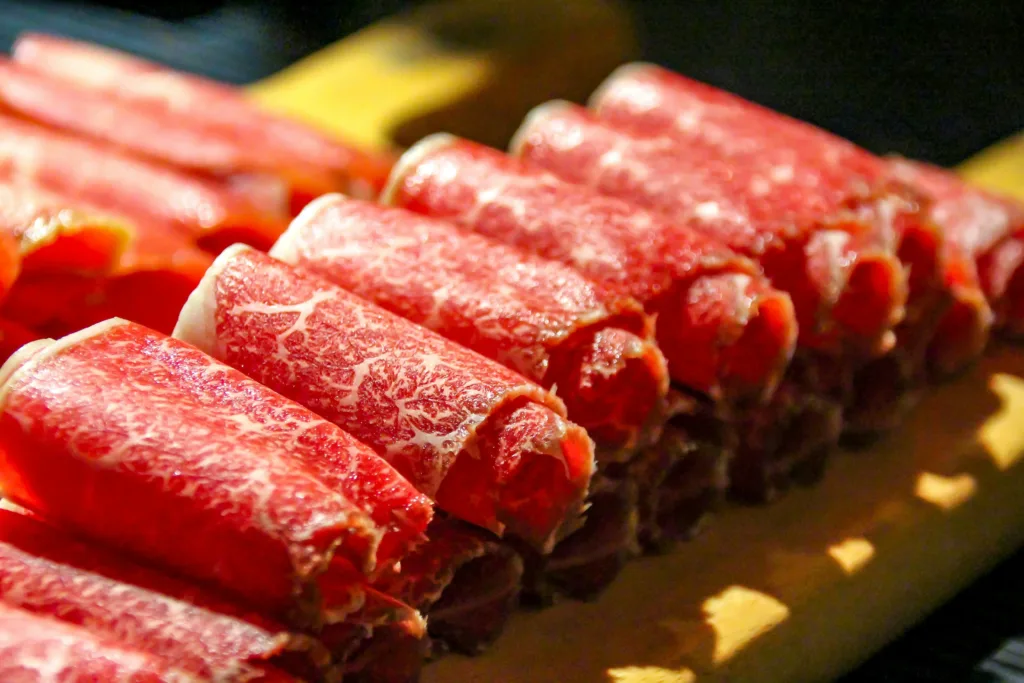Beef jerky’s got this in-between status – it’s often tossed in with health snacks because of the protein, but then flagged for sodium and additives. So what’s the deal? Is jerky actually good for you, or just better than chips? In this guide, we’re unpacking the facts: what’s inside your average strip of jerky, what makes some brands better than others, and how to pick one that actually supports your nutrition goals.
If you’re building a high-protein meal plan or trying to stay fuller between meals, beef jerky might be part of your snack strategy. With our app – ReciMe, you can save protein-rich recipes, plan balanced snacks alongside meals, and generate grocery lists that include the smarter kind of jerky – not the mystery meat kind with six types of sugar. Grab ReciMe now, power up your protein planning, and let’s dig into the facts on beef jerky.


So, What Exactly Is Jerky?
At its core, beef jerky is just lean cuts of meat that have been sliced thin, marinated, and dried out until chewy. That’s it. No smoke and mirrors – just a preservation method that’s been around for centuries. Drying the meat removes moisture (so bacteria can’t grow), while the marinade usually adds salt, flavor, and a little sugar. The result? A snack that doesn’t need a fridge and holds up on long hikes, long drives, or just long days at your desk.
Most jerky starts with beef round or brisket – basically, leaner cuts with less fat, which helps it last longer. The meat gets soaked in a marinade (think soy sauce, vinegar, spices, and sometimes sweeteners), then it’s either slowly dried in a dehydrator or cooked low and slow in an oven. Some brands take it further and smoke it for flavor, while others keep it soft and tender. It really depends on who’s making it – and how much they care about texture, ingredients, and the final chew.
It’s one of those snacks that seems simple, but the quality swings wildly depending on how it’s made. And when it’s done right? It can be a solid source of protein without a lot of fuss.

Why Jerky Can Be a Smart Snack
When jerky is made well – with quality meat and minimal junk – it can actually pull its weight in your diet. First off, it’s loaded with protein. Just an ounce can pack around 9 to 12 grams, depending on the brand. That’s the kind of protein hit that helps you feel full longer, which is why it’s often a go-to for folks trying to manage cravings or stick to lower-carb plans.
Beyond the protein, jerky also brings a few other nutritional wins to the table. It’s naturally low in carbs, especially if you’re skipping the overly sweetened varieties. And it sneaks in some essential micronutrients too – like iron (good for energy and red blood cell production), zinc (immune support), and B12 (for focus, metabolism, and not feeling like a zombie).
The convenience is a win in itself. It doesn’t need refrigeration, so it’s one of those snacks that actually works in real life – at work, in your bag, on a road trip, or just when you’re staring into the fridge hoping something will magically appear. If you find a jerky that skips the extra sugar and keeps sodium reasonable, it can be a surprisingly solid choice in your snack lineup.
What’s Actually in a Strip of Jerky?
If you’ve ever flipped over a bag of jerky and stared at the label, you’ve probably seen numbers all over the place. Some brands are pretty clean. Others? Not so much. But here’s a general snapshot of what you’ll find in 1 ounce (about one serving) of standard beef jerky:
- Calories: usually around 110-–120 kcal per ounce
- Protein: 9 to 12 grams
- Fat: typically around 7 g per ounce
- Carbs: about 3-6 g depending on added sugars
- Sugar: commonly 3-5 g
- Sodium: typically ranges from 300 to 600 mg per ounce, with some varieties exceeding 700 mg
- Iron: ~1.5 mg
- Zinc: ~2.3 mg
- Vitamin B12: Typically provides about 12% of the daily value per ounce, supporting energy metabolism and neurological health (based on brand data like Two Chicks Jerky)
So, what does that actually mean for you? The high protein is the big draw – it keeps you full and helps with everything from energy to muscle recovery. The iron and zinc are nice bonuses too, especially if you’re not getting those consistently elsewhere.
But sodium can sneak up fast. One serving might hit around 20% of your daily limit. That’s not a dealbreaker, but it’s worth keeping in mind – especially if you’re snacking on it often or pairing it with other salty foods.
Bottom line: beef jerky can be nutrient-dense for its size, but it pays to check the label. A few small tweaks – like skipping the sweetened versions or opting for low-sodium options – can make a big difference in how it fits into your day.

Can Jerky Help You Lose Weight?
It can – if you use it right. Beef jerky is high in protein and pretty low in carbs, which makes it one of those snacks that actually helps you feel full instead of just keeping your hands busy. That’s why it shows up in so many low-carb or high-protein diets. A couple of strips between meals can hold you over without sending your blood sugar on a rollercoaster.
That said, it’s not magic. Jerky is still calorie-dense, and it’s easy to overdo if you’re not paying attention. One serving is usually just an ounce, but let’s be real – who eats just one piece and puts the bag away? If you’re using jerky to support weight loss, portion it out, check the label, and pair it with other whole foods. Used strategically, it can absolutely be part of a balanced, satisfying plan.
Where Jerky Can Go Off Track
Beef jerky has its perks, but it’s not automatically a health food just because it’s high in protein. Here’s where it can slide into not-so-great territory:
- Too much sodium: One serving can hit 400-500mg, which adds up fast – especially if you’re snacking without thinking. Consistently high sodium intake can affect blood pressure over time.
- Added sugars in disguise: Some brands sneak in more sugar than you’d expect, especially in “teriyaki” or “sweet & spicy” flavors. Always check the label – some versions have as much sugar as a granola bar.
- Overprocessed meat: Not all jerky is made from clean, whole cuts of beef. Some use lower-quality trimmings, additives, or fillers, which kind of defeats the purpose of choosing it as a healthier option.
- Preservatives and additives: MSG and nitrates are generally considered safe in small amounts by food safety agencies, but some studies suggest potential issues, such as digestive sensitivities to MSG or links between nitrates and cancer risk with excessive consumption. Opt for simple ingredients to minimize exposure.
- Bigger picture: processed meat risks: Eating a lot of processed meats (like jerky, deli slices, or hot dogs) has been linked to higher risks of cancer, heart disease, and type 2 diabetes. Jerky now and then? No problem. But it’s better as an occasional snack, not a daily habit.
- Calorie creep: Jerky is calorie-dense for its size. If you’re eating straight from the bag, it’s easy to crush 2-3 servings without realizing it. A little mindfulness goes a long way.
How to Actually Pick a Healthier Jerky
Not all jerky is created equal. Some brands are basically salt bombs with sugar sprinkled on top. Others are surprisingly clean and protein-packed. If you want jerky that supports your goals – not fights them – here’s what to look for (and what to avoid) when you’re standing in front of that snack aisle.
Start with the Ingredients List
First thing to check? That tiny paragraph of ingredients on the back. The shorter, the better. Ideally, you want something like: beef, salt, pepper, vinegar, garlic. That’s it. When you start seeing things like corn syrup solids, caramel color, or “natural flavor” with no explanation… maybe put that bag back.
Watch the Sodium
A little salt is part of the process – it’s how jerky stays shelf-stable. But some brands go overboard. Try to aim for under 400mg of sodium per serving if possible. If that’s tough to find, at least balance it out with the rest of your day and don’t treat jerky like chips. It’s a snack, not a salt lick.
Skip the Sugar (Or Keep It Low)
A lot of jerkies add sugar for flavor, especially the sweet and spicy ones. But you don’t need that much sweetness in dried meat. Look for less than 3g of sugar per serving. Some of the better brands go completely sugar-free and still taste great.
Check the Protein-to-Calorie Ratio
This is a good trick. Look for jerkies where the protein grams are close to or higher than the calorie count. So if it’s 90 calories and 10g of protein? That’s solid. If it’s 90 calories and only 5g of protein? Meh. Keep walking.
Go Grass-Fed if You Can
It’s not just a trendy label. Grass-fed and grass-finished beef usually means higher-quality meat, better fats (hello, omega-3s), and no hormones or antibiotics. Plus, those brands tend to care more about what else goes in the bag too.
Avoid the Additive Overload
MSG, nitrites, artificial preservatives – you don’t need any of them in your jerky. A little salt, a few spices, maybe some vinegar? Great. A lab experiment’s worth of chemicals? Probably not what your body signed up for.
Bonus: Try a Few and Compare
Taste and texture matter too. Some jerky is soft and tender. Some is super dry and tough. You might find a favorite by trying a few different ones and comparing labels side by side. Once you find one that checks all your boxes, it’s easy to keep it in rotation.

Can Kids Eat Beef Jerky?
They can – but with a few things to keep in mind. Beef jerky is high in protein and easy to pack, which makes it a tempting snack for school lunches or road trips. But a lot of store-bought jerky is also loaded with sodium, which isn’t ideal for smaller bodies. If you’re tossing a piece into your kid’s lunchbox, try to choose lower-sodium options and keep the portion small – think of it as one part of a snack plate, not the main event.
Also, for younger kids (especially toddlers), texture matters. Jerky can be tough to chew, and big pieces can be a choking risk. If you’re offering it to little ones, slice it into smaller bites or go for softer, more tender varieties. The takeaway? Jerky isn’t off-limits for kids, but it’s one of those snacks that’s better with a little extra thought.
Conclusion
Beef jerky isn’t automatically healthy, but it’s also not junk food if you choose the right kind. It’s protein-packed, portable, and can definitely play a role in a balanced diet – especially if you’re watching carbs or need something to keep you full between meals. That said, not all jerkies are created equal. Some are basically sugar-glazed salt sticks pretending to be nutritious. Others are clean, simple, and made with solid ingredients.
If jerky’s already part of your snack routine, take a second to scan the label. A little sodium is expected, but sky-high numbers, added sugars, or mystery meat blends are worth avoiding. And if you’re building a high-protein plan, pairing jerky with fresh produce, healthy fats, or complex carbs can help round things out.
Whatever your goal – fueling up after a workout, managing cravings, or just needing a snack that won’t melt in your bag – jerky can work. Just be a little picky about what kind you buy. Your taste buds (and blood pressure) will thank you.
FAQ
1. Can I eat beef jerky every day?
Technically, yes. But most dietitians would say it’s better as a “sometimes” snack, especially because of the sodium. If it’s your daily go-to, try to balance it with low-sodium meals elsewhere in your day.
2. Is turkey jerky healthier than beef jerky?
It depends on the brand, but turkey jerky is usually leaner and a bit lower in fat. Still, sodium and sugar content can vary, so always check the label before assuming one is healthier than the other.
3. What’s the best kind of jerky to buy?
The best jerky is the one with a short, simple ingredient list, no added sugar, and moderate sodium. Grass-fed beef is a bonus, but the real win is avoiding anything that reads like a chemistry experiment.
4. Can jerky help with weight loss?
It can, if you use it right. Jerky is filling and high in protein, which helps curb cravings. Just keep an eye on portion size – it’s easy to over-snack if you’re eating straight from the bag.
5. Why is beef jerky so salty?
Salt is what helps preserve the meat during the drying process. It’s part of the deal, but some brands go way overboard. Look for options that stay under 400mg of sodium per serving if you’re watching your intake.
6. Can kids have jerky?
Yes, but with caution. Stick to smaller portions, choose softer or lower-sodium types, and avoid giving it to toddlers who might struggle with chewing or swallowing.
